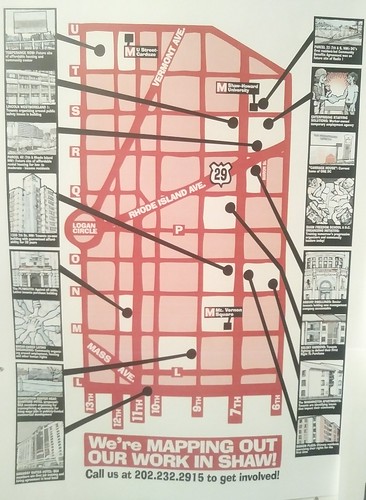One more thing about the Washington Post article on gentrification/displacement in the Shaw neighborhood
Years ago I had met with a graduate student, and she was talking about how her advisor argued that the Shaw area was resistant to gentrification, because of various community organizing and community organization initiatives.
Two groups that come to mind are Jubilee Housing and the Manna Community Development Corporation (now called One DC).

A c. 1980s? flyer about Manna initiatives in Shaw, from the "Right to the City" exhibit.
Key to Washington's urban revival was the creation of the Metrorail subway system, although the system's recent decline has significantly reduced usage.
While it is true that the Shaw area is home to some fascinating housing-related community organizing initiatives -- which you can learn about at the Right to the City exhibit at the Anacostia Community Museum, which reopens in October -- I disagreed that it was successfully resistant to change, making the point that it was merely a function of the attractiveness of the area in the context of the "regional residential choice landscape" and more specifically, the fact that the Metrorail line serving the area -- the Green Line -- opened last. of all the originally planned lines.
-- "Shaw (and Mid City East) as a one-over neighborhood: revitalization, displacement, gentrification as a function of critical mass and timing," 2013
The way "revitalization" works is that people live in the most desirable places first. They choose to live in adjacent areas when they can't afford to live in the primary area.
The Live Baltimore resident recruitment effort calls this phenomenon "the one-over neighborhood."
Shaw was only seemingly resistant to change. It's central location meant that change was only a matter of time.
Because the priming actions, in particular, putting in Metrorail service, the Green Line, set the stage for revitalization.
A few years ago, the Capitol Riverfront BID, served by the Navy Yard station on the Green Line, funded a market and economic analysis study of the Green Line, and published an update as well.
-- GreenPrint of Growth, 2012, Capitol Riverfront BID
-- GreenPrint of Growth 2.0, 2017, Capitol Riverfront BID
Over time, as demand remains high, large swathes of the city become what urban sociologists call "reproduced" and "the reproduction of space."
This process has been happening full force in Shaw for some time, with new construction of condominiums on U Street, 14th Street, and wherever land has been available.
As fallow sites get (re)developed and the inventory of land is depleted, other developers shift to existing properties.
To prevent displacement, long ago there should have been a program to buy, hold, and manage properties to maintain permanent affordability.
Labels: gentrification, neighborhood change, neighborhood planning, real estate development, residential real estate market





0 Comments:
Post a Comment
<< Home